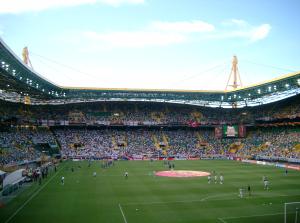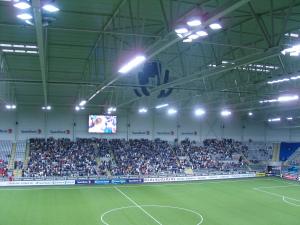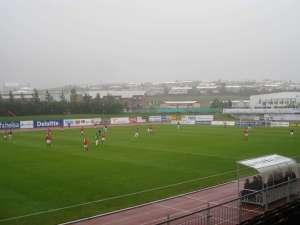This article was first written back in 2011 but is one of the top five viewed posts I’ve ever published – if you view it in terms of population of the highest ranked country, then everyone there would have read it….twice. Below was the original article and ranking back then with an update today to see how things have changed in the last eight years.
Two weeks ago I met a chap from Iceland at Copenhagen airport. His first words to me were “I’m the most passionate football fan in the world”. He had seen my Lewes FC Owners badge and knew exactly who the Rooks were, what league they were in and where they were in the league. In fact when I randomly fired obscure non league teams at it he could answer every single question on location, league and position. Curzon Ashton, Lincoln Moorlands Railways, Quorn. You name it, he knew the answer. He told me he watched about twenty games a week on the TV and Online, and devoted his whole life to following the beautiful game. He showed me his list of “favourite” teams from across Europe. His main team was KR Reykjavik back at home but also he avidly followed (deep breath here):-
Celtic, Rosenborg, Basel, Benfica, Helsingborgs, Rapid Wien, Olympiakos, Liverpool, AC Milan, Barcelona, Brondby, HJK Helsinki, Skendija Tetovo, Buducnost Podgorica, Hadjuk Split and BATE Borisov.
But this meeting got me thinking. Which nation are the most passionate about their own domestic league? My new “friend” in the thumbs up Inbetweeners way had claimed the Icelanders were – with just 12 clubs and a population of 328,000 he thought that more people watched top flight football in Iceland as a percentage than any other nation.
So in a spare moment (OK, hour) last week I fed all the relevant information into the TBIR super computer to see what the results were. Now, it is hard to be very exact and so I had to make a couple of assumptions.
- Population figures were taken from the CIA database
- To calculate the attendance of the league I took the league average attendance per game from 2010/11 (or 2011 in case of summer leagues) and multiplied by the teams in the league – this would roughly show the number of people who went to top flight football in a two week period (i.e a home game for each club). The bible for any statistical world is of course European Football Statistics.
- Obviously there is a small amount of overlap with away fans attending games so I took off 10% from the total to avoid double counting.
- I was unable to find league attendances for Andorra, San Marino or Malta. In addition there isn’t a league in Liechtenstein as their teams play in the Swiss league. However, the remaining 49 UEFA-affiliated Leagues were included.
The results were indeed very surprising. The top ten “most passionate” countries about their own domestic league have an average FIFA ranking of 53 (and a UEFA one of 23). There is only three countries in the top ten that are in the FIFA top ten, and the top three are all ranked by FIFA at over 118, and over 44 in Europe. So in true TBIR Top of the Pops style lets countdown from 10 to 1.
10th place – Switzerland (1.32% of the population watch a top flight match in 2010/11 season – Average attendance was 11,365 – Top supported club FC Basel who averaged 29,044)

2019 update – Switzerland has now dropped out of the top ten, falling to 11th place as of the end of the 2018/19 season, replaced by Sweden. Average attendance was 11,273 but for the first time in nearly 20 years, the best supported club wasn’t FC Basel. Champions Young Boys of Berne averaged 25,781 last season perhaps indicating a shift in power in the Alps? Oh, and Neuchâtel Xamax FCS have been born out of the ashes of the original club and are now playing in the Super League, whilst neither team from Zurich has finished in top spot.
9th place – Portugal (1.35% – 10,080 – SL Benfica 38,146)

2019 update – Portugal is the big climber in the last eight years, now in 5th rank. Benfica still remain the best supported team in Portugal although their average attendance has risen by almost 50% to 53,824 as they have won six of the last eight Primeira Liga titles. Average attendances across the league have also risen to 11,692 in 2019. The gap between the top and the bottom still remains with five of the eighteen clubs playing in the top division averaging less than 3,000.
8th place – Denmark (1.36% – 7,049 – FC Copenhagen 17,325)

2019 update – Whilst their % of people who attend has risen slightly to 1.43%, they have stayed in eighth place. FC Copenhagen haven’t had it all their own way in the last eight seasons, with titles being won by AaB, FC Mitjylland and FC Nordsjælland in that period, although FCK can still claim another five championships. Their average attendance has fallen slightly to 16,982 whilst the average for the Superligen has fallen to 6,562. Only FCK and city rivals FC Brondby currently average above 10,000, whilst at the other end, top flight new boys Vendsyssel FF average just over 2,300.
7th place – Belgium (1.54% – 11,574 – Standard Liege 25,125)

2019 update – Falling two places to number 9th in the list as the % of the population attending has dropped to 1.33%. The Belgium league has one of, if not the, most confusing end of season play-off structures and that perhaps explains why the title has been won by four different clubs in the last eight seasons. Standard Liege lost their top spot as the best supported team six years ago, replaced by Club Brugge KV, who average 24,399. The average across the whole of the Jupiler Pro League has fallen to 10,635.
6th place – Netherlands (1.87% – 19,296 – Ajax 47,316)

2019 update – Rising one place to 5th place despite seeing their percentage falling to 1.71%. Since 2003, the best supported team honor has fallen to Ajax who last season averaged 52,987 as they won the Eredivisie title for the 34th time. The league average has fallen to 17,998, predominantly due to the relegation to the second tier of FC Twente (averaging 26,274 in the second tier in 2019).
5th place – Norway (2.32% – 7,994 – Rosenborg BK – 14,510)

2019 update – Norway’s percentage has fallen to 1.55% and they have fallen one place to 6th. Rosenborg’s frozen grip on the Elite Serien title has now been broken with Molde winning this seasons’s title although they (and everyone else) cannot wrestle the grip of the best supported team away from Trondheim’s finest who in 2019 won the honor for the 18th season in a row with an average of 12,704. Attendances across the league were down for the 4th consecutive season at 5,780.
4th place – Scotland (2.82% -13,670 – Celtic 48,978)

2019 update – A big jump into 2nd place for the Scots, as their overall percentage has risen to 3.24%. A lot has happened in the last 8 years in Scottish football with all of the biggest clubs, bar Celtic, spending time outside of the Premiership. Unsurprisingly, bereft of the competition, Celtic have won the last eight titles and once again increased their average attendance thanks to redevelopment work at Celtic Park to 57,778 whilst the average across the league was at 15,990, the highest since 2007.
3rd place – Cyprus (3.5% – 3,067 – APOEL Nicosia 10,109)

2019 update – A fall of 4 places to 7th with their percentage dropping to just 1.53%. APOEL Nicosia have continued their domestic dominance, securing their seventh success title in 2019. They continue to be the best supported team on the island with an average of 4,414, significantly down on the figure from 2011. The average across the Cyta Championship has also fallen significantly down to just 1,701, with half of the league now averaging less than 1,000 per game. A lot of the blame for the drop in attendances has been down to the introduction of the mandatory Fan Card for all fans in a desperate attempt by the authorities to stamp out football-related violence.
2nd place – Iceland (3.69% – 1,123 – KR Reykjavik 2,148)

2019 update – A fall of one place for Iceland as their percentage has fallen to 3.24%. Icelandic football has been one of the success stories of the last decade. The national team qualified for their first major tournament in 2016 and reached the quarter-finals then two years later qualified for the FIFA World Cup Finals in Russia. They face a play-off for qualification for the 2020 tournament. Domestically, the average attendance has fallen to 1,018 and whilst KR have continued to be the best supported team, their average attendance has fallen to 1,623.
1st place – Faroe Islands (9.46% – 512 – B 36 Tórshavn 991)

“The impact of the English Premier League is everywhere in the Islands. I saw club hats and jackets at every ground I visited. The big-name shirts are on sale in the city centre, and even a rural bus-stop had a poster for a competition to win tickets to the United-City FA Cup semi-final at Wembley. The games are shown on TV, a week after the event. I can’t say that it makes me feel good as an Englishman to find this.
Most of the adults that I spoke to at the games were in touch with Premiership events and had an English team that they supported. Liverpool more than most, I’d say, especially for the 30-something-plus generation. There seemed to be more affinity for northern or coastal sides, and the original inspiration was more often than not a prima donna goalscorer.”
2019 update – Despite their percentage falling to 8.1%, The Faroe Islands is still the best supported team per capita. Not much has changed in the rugged northern islands with the average attendance slipping to 438 and the best supported club now KÍ Klaksvík who average 731.
For those who wanted to know, England were 11th in 2011 and are now 13th, Spain 13th (now 12th) and Germany 18th (now 16th) on the list. So the moral here is if you do meet a mad Scandinavian at the airport, keep your headphones on, look straight ahead and play dumb.

